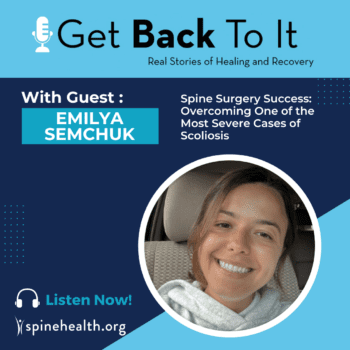By Jacqueline E. Inglis, BA , Northwestern University Feinberg School of Medicine
By Wellington K. Hsu, MD , Northwestern University Feinberg School of Medicine

BACKGROUND
One of the main concerns for an elite athlete is return to play (RTP) following spinal surgery. There are currently no evidence-based standardized guidelines, therefore these decisions are largely reliant on expert opinion and patient factors. There has been an evolution of management and treatment for cervical (neck) disc herniations in the elite athlete, especially those in collision sports, such as American football and rugby. Major factors guiding physician counseling include clinical recovery, patient goals, radiologic imaging, and historical data on successful RTP.
4-PRONGED APPROACH
At our institution, we employ a four-pronged approach to evaluating the elite athlete with a cervical disc herniation:
- clinical presentation
- imaging parameters
- physical examination
- sport played
If a player fails conservative management of their neck injury, such as therapy, rest, time, activity modification, and medications, then two common surgical options include: anterior cervical discectomy and fusion (ACDF) and posterior foraminotomy (nerve decompression).
AFTER SURGERY
Clinical indicators for RTP after surgery are still under debate, but are applied similarly to both procedures.1,3 The following preclude a player from RTP:
- persistent neurological deficits (weakness/dense numbness)
- spinal canal stenosis
- fusions involving the upper cervical spine (C1-2, C2-3)
- greater than three spinal level fusions
Relative contraindications include:
- fusion of two cervical levels
- asymptomatic fusion failures
Athletes that meet the following criteria are generally cleared to play:
- adequate fusion
- spinal stability
- full ROM
- lack of neurological deficits
- controlled pain
OTHER CONSIDERATIONS
Another important consideration from the patient perspective is the risk of reinjury. Collision sports, such as American football and rugby, are associated with a greater relative risk of hyperextension and compression injuries to the spine thereby increasing chances of reinjury and traumatic stenosis. Lastly, social factors and career longevity goals are important factors in shared decision-making between physician and patient.3
IMAGING PARAMETERS
The use of radiologic imaging parameters can be used as an objective measure for recovery. The Torg-Pavlov ratio compares the spinal canal width to the vertebral body width on MRI to determine the degree of stenosis (narrowing of the space for the spinal cord). There is still debate about the threshold value of the Torg-Pavlov ratio when it comes to return to sport, but in general RTP is not recommended if the ratio is indicative of stenosis associated with spinal cord injury.1,4 Other imaging parameters include spinal cord and spinal canal diameters as predictors of cord injury and stenosis. MRI can reveal persistent edema in and around the spinal cord, however there is debate whether this should preclude an athlete from returning to play as some players have demonstrated successful RTP while others are advised to retire from sport. Use of these imaging parameters can help gauge successful recovery and give an athlete a better understanding of the feasibility of returning to a demanding level of sport.1-2
RESEARCH
In a retrospective study following football players treated with a single level ACDF, 72% of NFL players returned to play for an average of 2.8 years as opposed to players treated nonoperatively, who returned to play for an average of 1.5 years.5 A similar study found that 71% of NFL players were able to return to play 2-12 months after ACDF for an average of six months.6 Rugby players appeared to have slightly more success, with 76% of rugby players returning to sport after ACDF.7 There are discrepancies in outcomes when comparing ACDF to posterior decompression without fusion. Some studies report a greater frequency in return to play with quicker recovery but a greater chance of reoperation after decompression alone and others find no significant difference between decompression and ACDF in terms of RTP.8
BOTTOM LINE
Ultimately, the main consensus is that much is still unknown about RTP after surgical interventions for the elite athlete. Currently, the best guides are clinical recovery of the athlete, imaging indicators, and evidence from previous athletes. When counseling a patient, all of these factors must be taken into account to provide the best picture on timing and successful return to play. Moving forward, additional studies, especially in relation to imaging and athlete success, may provide more defined guidelines for safe RTP.
You can read more stories from our spine health journal here.
REFERENCES
- Hsu, W. K. (2021). Transient Quadriparesis and Cervical Neuropraxia in Elite Athletes. Clin Sports Med, 40(3), 463-470. https://doi. org/10.1016/j.csm.2021.03.003
- Watkins, R. G. t., Chang, D., & Watkins, R. G., 3rd. (2018). Return to Play After Anterior Cervical Discectomy and Fusion in Professional Athletes. Orthop J Sports Med, 6(6), 2325967118779672. https://doi.org/10.1177/2325967118779672
- Swiatek, P. R., Nandurkar, T. S., Maroon, J. C., Cantu, R. C., Feuer, H., Bailes, J. E., & Hsu, W. K. (2021). Return to Play Guidelines After Cervical Spine Injuries in American Football Athletes: A Literature-Based Review. Spine (Phila Pa 1976), 46(13), 886-892. https://doi.org/10.1097/ BRS.0000000000003931
- Lee, Y., Selverian, S., Hsu, W. K., Watkins, R. G., Vaccaro, A. R., & Hecht, A. C. (2021). Asymptomatic Spinal Cord Compression: Is Surgery Necessary to Return to Play. Neurosurgery, 88(5), 955-960. https://doi.org/10.1093/neuros/nyaa554
- Hsu, W. K. (2011). Outcomes following nonoperative and operative treatment for cervical disc herniations in National Football League athletes. Spine (Phila Pa 1976), 36(10), 800-805. https://doi.org/10.1097/BRS.0b013e3181e50651
- Maroon, J. C., Bost, J. W., Petraglia, A. L., Lepere, D. B., Norwig, J., Amann, C., Sampson, M., & El-Kadi, M. (2013). Outcomes after anterior cervical discectomy and fusion in professional athletes. Neurosurgery, 73(1), 103-112; discussion 112. https://doi.org/10.1227/01. neu.0000429843.68836.91
- Andrews, J., Jones, A., Davies, P. R., Howes, J., & Ahuja, S. (2008). Is return to professional rugby union likely after anterior cervical spinal surgery? J Bone Joint Surg Br, 90(5), 619-621. https://doi.org/10.1302/0301-620X.90B5.20546
- Leider, J., Piche, J. D., Khan, M., & Aleem, I. (2021). Return-to-Play Outcomes in Elite Athletes After Cervical Spine Surgery: A Systematic Review. Sports Health, 13(5), 437-445. https://doi.org/10.1177/19417381211007813


